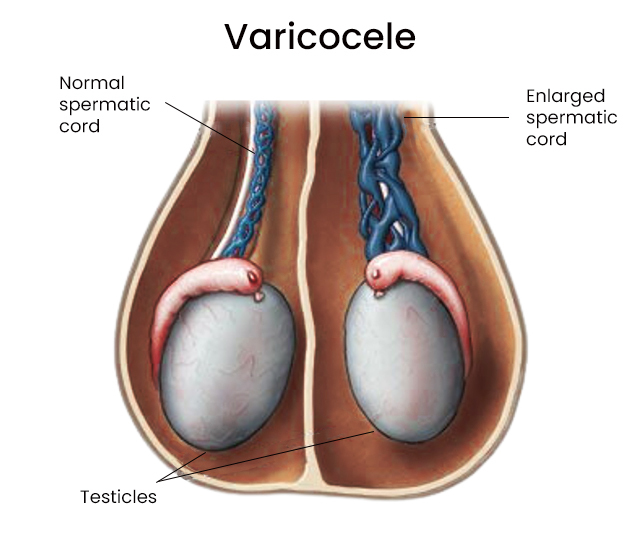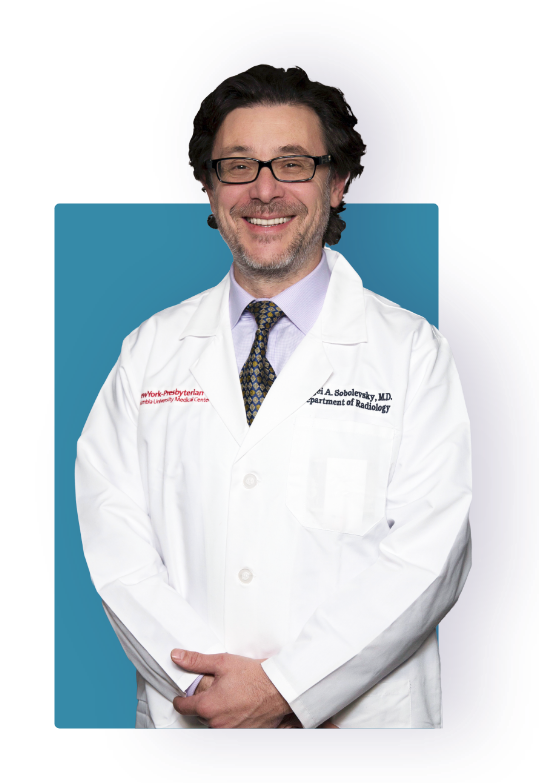An enlarged vein inside the scrotum can turn painful and cause other symptoms that may affect your sex drive, fertility, and overall quality of life. Even though it is not a life-threatening condition, it signifies defective valves in the veins that allow blood to pool in the scrotum. Visit Downtown Vein & Vascular Center if you notice any abnormalities like twisted or swollen veins or pain in your scrotum for expert guidance. Dr. Sergei A. Sobolevsky uses the most advanced diagnostic tools to determine your condition and comes up with the best solutions to resolve your symptoms. He specializes in treating scrotal varicoceles for men and recommends safe and effective methods to ease your discomfort.
Varicoceles are a common disorder of the veins inside your scrotum, the protective sac that protects and holds your testicles. Having a varicocele means the veins inside your scrotum are enlarged or wider than they should be.
They may cause pain, infertility, or one testicle to shrink or grow slowly.
What Is a Varicocele?
A varicocele is the enlargement of the veins within the scrotum or loose bag of skin that holds the testicles. These veins transport oxygen-depleted blood from the testicles. A varicocele occurs when blood pools in the veins rather than circulating efficiently out of the scrotum, causing twisted and swollen veins. Varicoceles are similar to varicose veins that develop in your scrotum and make them swell and lose their shape.
Varicoceles usually form during puberty and develop over time. They are often painless but may cause discomfort or pain in the testicles that comes and goes. A varicocele can affect fertility in some men.
Varicoceles are more common on the left side of the scrotum. Out of 100 males, 10 to 15 have varicocele. Read on to learn more about varicoceles, including their symptoms and treatment options.

What does a varicocele look like?
A varicocele often causes no symptoms. If you have several varicoceles, your scrotum may look or feel like a bag of worms.
Some visibly noticeable symptoms of varicoceles are:
- A twisted appearance
- One testicle that appears larger or heavier than the other
- Enlarged veins in the scrotum, commonly found on the left side
- A lump in the testicle
- Swelling testicles or scrotum
Other varicocele symptoms may include:
- A dull, heavy aching sensation in the scrotum
- Pain that gets worse when you are standing
- Pain that lessens when you lie down
- Pain that gets worse in hot weather
- Pain that gets worse after exercise
Testicular self-examination can help identify varicoceles. If you experience any unexplained symptoms or pain in your scrotum, it is essential to see your doctor right away, before this pain worsens or becomes a health complication.
What Causes Varicoceles?
There may be many causes of varicoceles, but there is no confirmed theory about why they develop. If the valves in the vein are not working right or they are missing, it can lead to varicoceles. In addition to this, if the blood flow is sluggish, blood may pool in the veins.
Also, the larger veins moving from the testicles toward the heart are connected differently on the left and right sides. More pressure is needed on the left side to keep blood flowing through the veins toward the heart. If blood flows backward or pools in the veins, it can make the veins swell.
In rare cases, swollen lymph nodes or other masses behind the belly block blood flow, which can lead to sudden swelling of the scrotal veins.
Possible Complications of Varicoceles
Varicoceles do not cause serious health complications but may affect testosterone production. Low testosterone levels can lead to health and lifestyle concerns.
Symptoms of low testosterone may include:
- Fatigue
- Weight gain
- Low sex drive
- Depression
- Trouble sleeping
- Difficulty concentrating
- Erectile dysfunction
This condition can also affect male fertility. Swollen veins and backed-up blood can change the temperature, blood flow, and pressure inside the testicles, which may affect sperm count and sperm motility. Luckily, if a varicocele is causing low testosterone levels and fertility issues, treatment can help improve testosterone production, restore fertility, and improve your chances of conceiving.
Read more: How to Treat Spider Veins on Your Face
Diagnosing Varicocele
Your healthcare provider may diagnose a varicocele after examining your symptoms during a physical exam. You will be examined while lying down and standing up as it makes a varicocele easier to detect.
To confirm the diagnosis and get more details of your testicular veins, the doctor may recommend an ultrasound test.
If you are concerned that a varicocele may affect your fertility, your doctor may ask you to go for a semen test.
Treatment Options for Varicocele
A varicocele often doesn’t need to be treated if it is not causing any discomfort or other issues. But, it becomes necessary to seek treatment if it is causing pain, testicular atrophy, or shrinking of your testicles and causing infertility.
There are a variety of medical procedures that can help to treat varicoceles. They include:
Varicocelectomy – It is a surgical procedure for treating varicocele. It reduces testicular pain and can increase male fertility. The specialist will go in, through your abdomen or pelvis, and clamp or tie off the abnormal veins. Blood can then flow around the abnormal veins to the normal ones. It is a safe procedure that can help improve fertility by restoring blood flow to the scrotum and increases sperm and testosterone production.
Varicocele embolization – It is a less invasive procedure in which the specialist makes a small incision in the groin and threads a very thin catheter through the femoral vein. The catheter is directed to the varicocele, and the specialist inserts a small coil or a special fluid into the affected vein. The coil or fluid works to block blood flow. When the blood is prevented from getting to the abnormal veins, the varicocele shrinks and gradually disappears.
Treatment options are based on the degree of discomfort or infertility issues you have.
Discover other treatments our top vascular doctors offer:
Read more: 7 Easy Solutions to Improve Blood Circulation in Legs and Feet
Benefits of Varicocele Embolization
The varicocele embolization procedure is far less invasive than many other treatments for vascular disorders. The procedure can usually be performed in an outpatient setting. The doctor uses a local anesthetic, which means you can go home shortly after the procedure is complete.
Recovery time is also short with varicocele embolization, as compared to invasive surgical treatments. You can return to your routine activities within a few days. As the procedure only leaves a small incision, there is less risk of infection and a minimal chance of scarring.
Knowing what a varicocele looks like and what symptoms you may have can help you make a better decision to protect your health and fertility. Do not ignore symptoms of varicocele, such as a scrotum that looks or feels like a bag of worms or pain and heaviness in the testicles, as it could affect your sex drive and fertility. Visit Downtown Vein & Vascular Center to find out more about vein abnormality in the scrotum and how it can be treated effectively. Dr. Sergei A. Sobolevsky investigates the causes behind your symptoms and suggests treatment options to prevent this condition from worsening or causing lifelong complications.

Sergei Sobolevsky, MD, is a leading specialist in endovascular medicine with experience in vascular and interventional radiology. Dr. Sobolevsky has decades of experience in the field, with over 25,000 procedures performed, accumulating extensive experience in image-guided minimally invasive medicine, diagnosing and treating a range of conditions.
Dr. Sobolevsky earned his Doctor of Medicine (MD) degree in 1997 from the University of Colorado School of Medicine. He received his specialty clinical training in vascular and interventional radiology at Harvard University. Later, he earned his MBA from the MIT Sloan School of Management. Recognized as a Castle Connolly Top Doctor and named to the Top Doctors New York Metro Area in 2020, 2021, and 2022, Dr. Sobolevsky is licensed in multiple states, has delivered presentations at numerous institutions in the US and abroad, and now acts as a clinical advisor for the biomedical industry. He also held multiple positions in the field during his career, including Chief of Vascular and Interventional Radiology at the Columbia University Medical Center in New York, NY, Senior Vice President in Clinical and Regulatory Affairs at Artann Laboratories in North Brunswick, NJ, and Medical Director at the American Endovascular and Amputation Prevention Center in Brooklyn.
More About Dr. Sobolevsky

